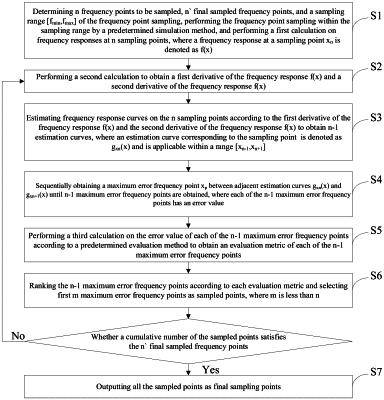| CPC H01Q 3/22 (2013.01) | 9 Claims |

|
1. An adaptive frequency sweeping method for frequency point sampling, applied to simulation of radio frequency (RF) components, comprising:
S1: determining n frequency points to be sampled, n′ final sampled frequency points, and a sampling range [fmin, fmax] of the frequency point sampling, performing the frequency point sampling within the sampling range by a predetermined simulation method, and performing a first calculation on frequency responses at n sampling points, wherein a frequency response at a sampling point xn is denoted as f(x);
S2: performing a second calculation to obtain a first derivative of the frequency response f(x) and a second derivative of the frequency response f(x);
S3: estimating frequency response curves on the n sampling points according to the first derivative of the frequency response f(x) and the second derivative of the frequency response f(x) to obtain n−1 estimation curves, wherein an estimation curve corresponding to the sampling point xn is denoted as gxn(x) and is applicable within a range [xn−1,xn+1];
S4: sequentially obtaining a maximum error frequency point xp between estimation curves gxn(x) and gxn+1(x) of two adjacent sampling points until n−1 maximum error frequency points are obtained, wherein each of the n−1 maximum error frequency points has an error value;
S5: performing a third calculation on the error value of each of the n−1 maximum error frequency points according to a predetermined evaluation method to obtain an evaluation metric of each of the n−1 maximum error frequency points;
S6: ranking the n−1 maximum error frequency points according to each evaluation metric and selecting first m maximum error frequency points as sampled points, wherein m is less than n, and m and n are integers greater than 0; returning to the S2 for iterative execution if a cumulative number of the sampled points does not satisfy the n′ final sampled frequency points; stopping the iterative execution if the cumulative number of the sampled points satisfies the n′ final sampled frequency points; and
S7: outputting all the sampled points as final sampling points.
|